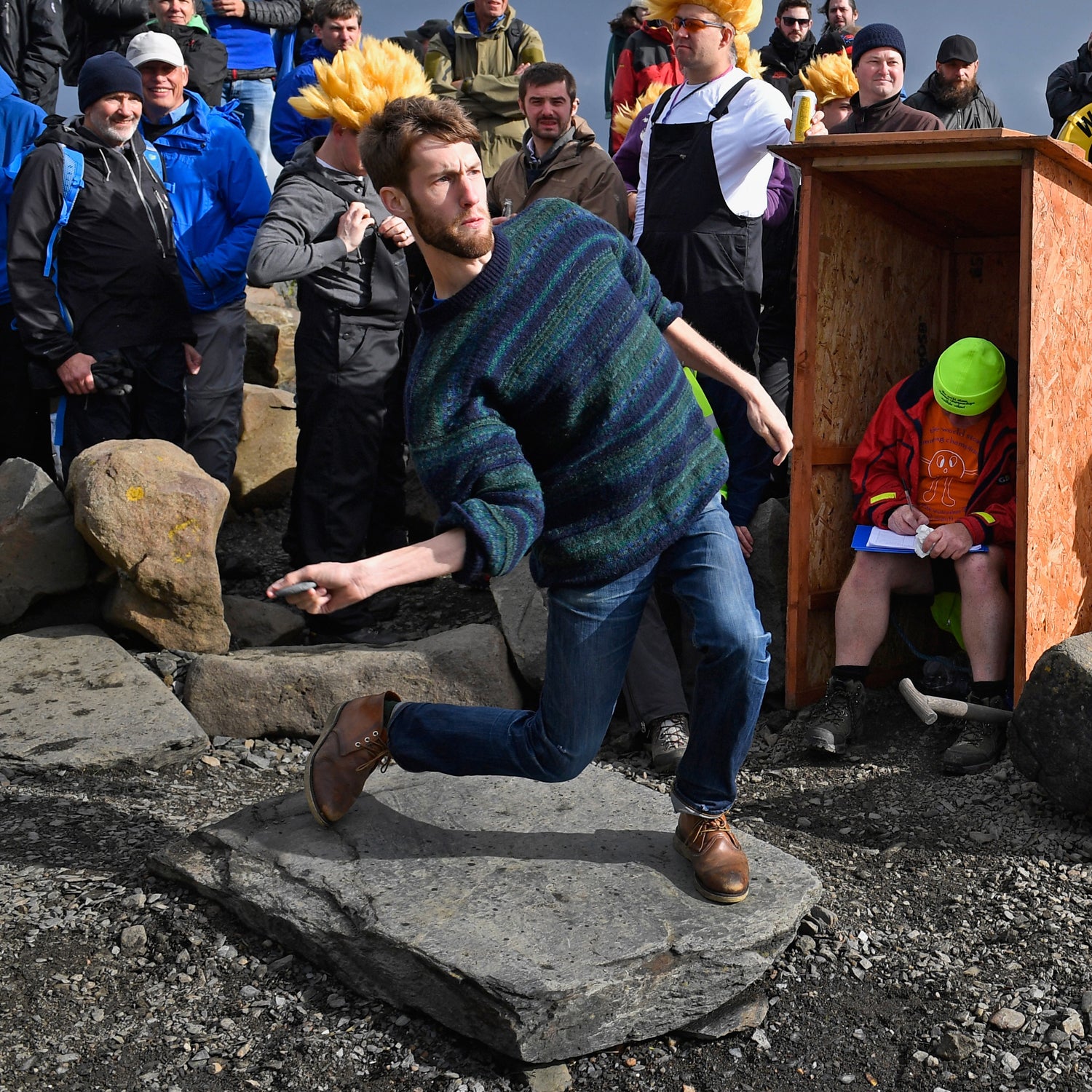Fog shrouds Easdale Island, a windswept 62-acre chunk of slate, grass, and shrubs just off Scotland’s west coast, as rain intensifies on the roof of the Puffer Bar and Restaurant. Four of Easdale’s 60 residents guffaw over dominoes in the cramped dining area, and a fifth pours English-style IPAs behind the bar. Easdale is the smallest permanently inhabited island in the Inner Hebrides archipelago of Scotland, but its population is about to swell. The coming hordes descend not for whisky tours, mountain biking, or Highland games. They come for stone skimming.
Every fall for 20 years, Easdale has hosted the World Stone Skimming Championships. Originally dreamed up in a bar as a wee bit of fun, the event now draws 350 skimmers and a couple hundred more spectators. Proceeds keep the island’s community hall, harbor, and museum running. Most competitors hail from Scotland, but others travel from Wales, Britain, the Netherlands, the United States—even Hong Kong and India.
This September, I decided to join them. At the pub, I hand an IPA to Hans Eshuies, a Holland-based landscape architect who’s become a regular at the competition. In May, he participated with other elite skimmers in a Wales competition to determine an official stone-skip distance record for the Guinness Book of World Records. Englishman Paul Crabtree, a former stone-skimming champion, enters the bar. “Maybe Dougie’s car broke down,” he says.
Dougie Isaacs, a delivery driver from central Scotland, is the perennial champion. He’s won this event seven out of the past 12 years and set the official world record for longest stone skip—351 feet—at the Guinness book toss-off. Eshuies describes Isaacs as a mystery man who arrives quietly and makes stones whoosh audibly when he throws them. He arrives quietly at sunset in a worn commando jacket, bantering with the ferry operators, and keeps a low profile. Year after year, Isaacs awes spectators and other skimmers. But everyone wants to see him challenged.
Those who are passionate about the World Stone Skimming Championships take it very seriously. Back home in Holland, Eshuies molds his own skimming stones out of white concrete and practices with them, though only hand-picked natural Easdale slate can be thrown in the event. Welshman Ron Long, the 2012 winner, also produces artificial stones, which he feels level the playing field in competitions by removing variables like rock shape and weight. He sees big—even Olympic-sized—possibilities for the sport.
“In the Olympics, they can get horses to do God knows what. Stone skimming could be developed worldwide. Every man and his dog skims stones.”
“In the Olympics, they can get horses to do God knows what,” he says. “Stone skimming could be developed worldwide. Every man and his dog skims stones.”
He’s right. Practically every kid who has been near a rocky shoreline has scoured the beach for a smooth, flat rock and attempted to skip it. Easdale, once central to Scotland’s slate industry, offers the perfect setting for doing so. The beaches hold seemingly infinite pieces of smooth slate. Cliffs line the quarry where the event takes place, shielding the water and creating an all-natural stadium effect.
Contestants get three throws, each measured for distance, provided they go a minimum of three skips. The longest toss counts. Throws of 207 feet hit the cliff wall on the opposite side of the quarry in dramatic fashion and earn a burst of cheers from the crowd. Event organizer and Easdale resident Donald Melville, known as Melon, records the distances of more than 1,000 throws over four hours, announcing each skimmer’s name with a gusto-filled brogue.
Though a crop of the sport’s devotees have organized around clubs—there’s a North American Stone Skipping Association and a handful of other stone-skimming competitions in the United Kingdom and the Netherlands—but Easdale’s event claims to be the world championship. Ask Melon why, and he flashes a wry smile. “Because we said it is.”
Rare sun glistens on the quarry waters for the 2016 competition. Stiff wind ruffles the water all day, making for difficult skimming conditions. No one hits the back wall, but a couple come relatively close. Crabtree stares down his 164-foot toss with his hands on his hips, and Eshuies reaches 187 feet to move into second place. Then Melon announces Isaacs. Onlookers brandish their cameras and whisper giddily. The champ removes his commando jacket. Three fluid, powerful motions and three dead-straight throws. None hit the back wall, but everyone knows the longest, 200 feet, will hold up.
“Looking forward to seeing you all next year,” Isaacs says at the awards ceremony after collecting his prize: Oban single malt whisky. Crabtree and Eshuies congratulate him, and Melon offers a heartfelt sendoff. Exhausted volunteers hug each other as the rain returns. Something feels right about a Scot winning the title yet again. Then the mini ferry departs the mini island, leaving residents to toast another successful year over pints in the Puffer.
Stone Skimming 101
Want to impress friends during your next lakeside camping trip? Whether you count skips or estimate distance, you want to balance power with technique—and, perhaps most crucially, pick the right stones.
- Find flat, smooth rocks roughly three inches in diameter. While some folks prefer perfect circles, finding a rock with a notch or corner for your pointer finger will help you achieve maximum spin, which will keep your stone skipping.
- When you throw the stone, remember that it will tend to tip in flight. Release it low enough to keep it flat. Compensate for wind speed and direction.
- Use enough power to make the stone spin but not enough to compromise your technique.
While Isaacs whips stones with the easy power of a shortstop, Eshuies pictures the stone’s contact with the water. “It has to not hit the water—it has to kiss the water,” he says. Crabtree takes an everyman approach: “I’m always reminded that you can do it all right, and still it won’t always be good.”

